Anatomy of a Ring
The different parts of a ring and what to look for in each
Knowing the different parts of a ring can help you make a better decision when choosing a new ring and it can help you know when your ring may need maintenance. It’s also a fun way to impress your friends with your vast knowledge of jewelry terms.
Shank
Every ring has a shank. This is the technical term for the band of metal that encircles the finger. There would be no ring without the shank. If the ring has a distinct design feature on the top part, the ring shank is generally said to start at the point that the design stops.
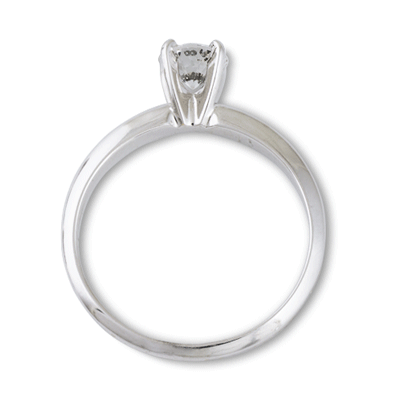
A jeweler will usually add or remove metal from the bottom of the shank when sizing a ring. This can sometimes be done so well that you would never know it was sized looking at the shank with your naked eye.
Over time, the shank can wear thin—yes, even gold and platinum can wear away. In such cases a jeweler can “re-shank” the ring by replacing the metal at the bottom of the shank, going as far up the sides as the design and the extent of the wear require. If you are careful with your rings (removing them when doing dishes, cleaning with harsh chemicals, gardening, etc.), the shank may last your lifetime and beyond. But, shanks that were thinner to begin with are more likely to need attention sooner.
When shopping for a ring, look for one with a sturdy, thick shank that will provide plenty of wear while still fitting with the overall design that you like.
Gallery
The gallery of a ring is a somewhat ambiguous term that refers to the underside of the ring beneath the center stone. There is often a design on the top part of the ring that is lifted up above the finger. In order to maintain the structural integrity and comfort of the ring, a gallery is added beneath this design that supports it and hugs the top of the finger.
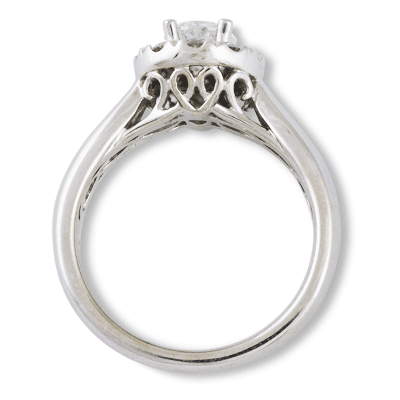
In terms of maintenance, sometimes a ring gallery will be made up of thin wires which can wear and break or crack over time. The gallery is also a prime location to see wear caused by other rings (e.g. wedding bands) that are worn next to each other. The constant friction with another ring can actually wear through the gallery leaving the center stone at risk of calling out. This is why we typically recommend that you have your rings soldered together if you plan to wear them together all the time.
When you are looking for a ring, pay attention to how the gallery is made. Does is look substantial enough to hold the ring together? Are the gallery wires thin and easily breakable? Will it accommodate any bands or other rings you plan to wear next to the main ring?
Head
The head is the piece that holds the gemstone. Pronged heads are most common. The prongs are the little claws of metal that secure the stone. Most prong heads in rings feature four or six prongs. Six prong heads are more secure because there are more points that have to fail for the stone to come out, but they also cover up more of the stone.
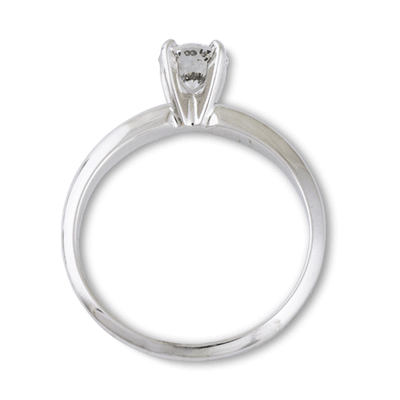
Prongs, like shanks, can wear away and need to be built up to prevent the stone from falling out. The very top of the prong—the part that actually rests on top of the stone—is called the “tip.” It’s always a good idea to have your prongs checked by a jeweler, especially if it looks to you like any of the tips are missing or worn down, or if any stones are loose. The more tips that are thin or missing, the more likely you are to lose a stone.
In addition to prong heads, you can also find bezel, half-bezel, and channel heads. A bezel head encircles the entire stone in metal and is possibly the most secure way to set a stone. Some people dislike the style, however, because it obscures more of the stone. The half bezel is a solution to this that features metal that features two pieces of metal that wrap approximately a quarter of the way around the stone on opposite sides of it. Finally, a channel head sets the stone in between two straight pieces of metal on either side of it (this style is most commonly seen with square or princess cut diamonds). As you may have guessed, all styles of head can wear thin over time and may need to be built up by a jeweler.
When you are shopping, pay close attention to how the main diamond or gemstone is set. What style of head is used? What trade-offs are being made between security, design, and how much of the stone is visible?
As a final point on heads it is important to note that not all rings have a head. Some designs incorporate the setting of the gemstone directly into the rest of the ring without using a separate part. These designs can use a combination of prongs, channels, beads, or flush setting to hold the center stone in place. The important thing to note here is that the stone must be set somehow, so focus on what is holding the gemstone in place to decide if you like a particular ring or if your ring needs some maintenance.
Cathedral
A cathedral is a specific ring style that features arches of metal extending up from the top of the shank, creating an open space. These arches are called the cathedrals. There are various styles and thicknesses of cathedral arches. Some are sleek and plain, some are wider and covered in accent diamonds. The size and cut of the center stone also may vary, but when you see those arches of metal rising up toward the center, you’ll know, it’s a cathedral ring.
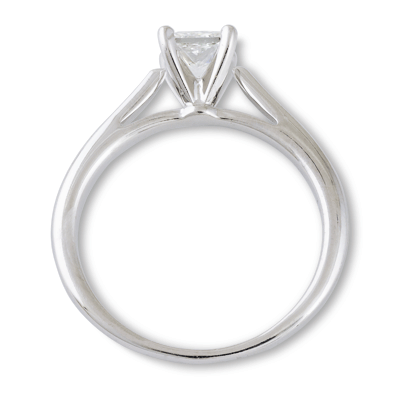
Cathedrals integrate the center top of the ring with the rest of the design creating a flowing line in contrast to simple solitaire rings which leave the center stone hovering in space above the ring shank. This design feature also adds a degree of security to the center stone as the arches can protect it from some side impacts. It also creates a difficult to clean area on the underside of the cathedral arches that can build up with dirt over time.
We created an entire video on cathedral rings which you can checkout if you are interested in learning more about them.
Halo
Halo rings have been very popular for sometime and so you may be familiar with this one already. The “halo” refers to the stones that surround the center stone, or sometimes center cluster. There are many styles of halo rings. A halo can be a variety of shapes and contain different cuts of stones. There can even be multiple halos forming concentric circles around the center stone.
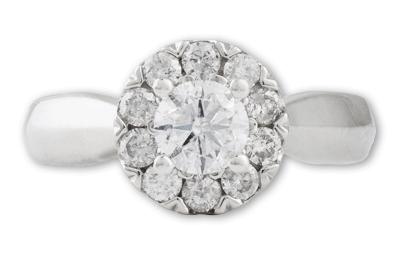
The metal on the outside of the halo that holds in the accent stones (typically small beads) is prone to wear over time leaving those stones at risk of falling out. Beyond that, there aren’t any particular maintenance or structural issues that halos bring to most rings. In fact, like cathedrals, they can even help protect the center stone from damage.
If you are shopping for a halo engagement ring, first look for the overall shape of halo that you like (e.g. round, cushion, square, something else), and then consider how the accent stones in the halo are set. Are they secure? Will the halo help protect the center stone from impact?
So there you have it. A brief introduction to the anatomy of a ring. We hope this has been helpful, and please feel free to leave us a comment if you would like to know more about any of these parts or if there was a part that we missed. If you are looking for the perfect ring, browse our online shop or contact us and one of our jewelry experts would be happy to help you find a ring that’s more than the sum of its parts.
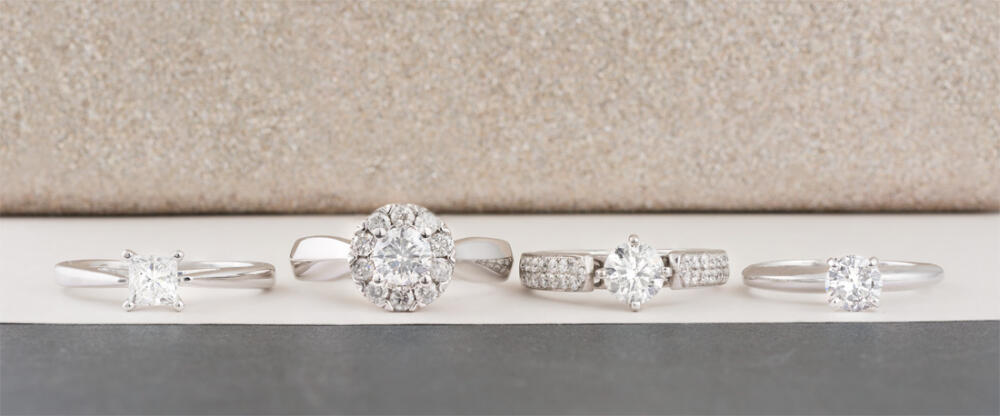

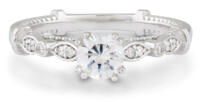
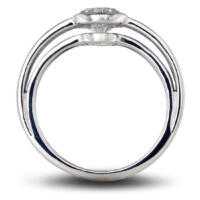
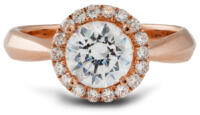
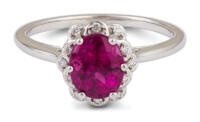
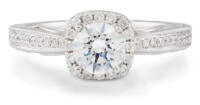
I have or had my Grandmother’s engagement ring circa 1915 but neither my mother or I ever wore it as one of the five small stones (3 Sapphires with a diamond separating each) a couple of the
claws were bent/broken a repair with a silver metal had been used to attempt a repair. I decided to have it repaired put it in the Jewellers 3 months ago kept phoning and kept being told he was searching for a matching colour of sapphire. I said I had concerns he’d lost the ring and would be in the fol!owing week. On arriving he showed me a stunning ring same description as the original but everything about it sparkles as new and I’m thinking this is NOT my Gran’s ring there is no sign of silver metal repair! Do you think it’s possible to refurbish a 119 year old ring to look brand new or is he conning me as he’s lost the real ring? The repair charge was £150, which for such a beautiful ring is cheap, but can this possibly be my Gran’s ring? Are there signs I should look for? I had wanted to pass ring to my granddaughter.
Your thoughts would be greatly appreciated.
Hello Mrs. Robertson, thanks for reaching out. That is a tough question, and, unfortunately, not one that I could answer accurately without having seen the ring before it was sent in to the shop. What I can tell you from personal experience is that I have had similar conversations with clients after finishing a repair. If we do an extensive refurbishing on an old and significantly worn ring, sometimes the client will think it’s a totally different ring. We get so used to our jewelry looking a certain way that when it’s cleaned and refurbished, it becomes almost unrecognizable. I’m not saying that’s the case here, but I thought I would share that with you in case it is helpful.
I’m wondering if you could tell ne whether this ring needing repair needs to have extra prongs inserted in the Head area. I acquired the ring in this stte and have no idea what it looked like originlly. Currently it only has 4 prongs that need retipping, but I’m wondering if it needs one of those inserts with claws on them inside the ring as currently the depth of the gallery area i 5mm, while the diameter of the missing stone is also 5mm. I can’t work out how to send you a photo of the ring setting.
Hi Julie, thanks for reaching out. Without seeing the ring in person, it’s difficult to say if it might need additional prongs. Four prongs can be sufficient depending on the size and shape of the stone as well as the design of the ring, but sometimes additional prongs are a good idea. You can always email us some pictures of the ring at: service@mygemologist.com. We would be happy to take a look and give you our recommendations.
What type of ring has a shank that splits at the top and appears to only hold the head/gemstone? There is open space on either side of the head when viewing it from the top. The main stone is held by prongs and sits higher than the shank. Also, can a wedding band be added to this type of ring?
Good question, Georgia. We typically call that style a split shank. You can see some examples on our website here. Yes, a wedding band can typically be added to split shank rings. Sometimes, the designer will already have one made that goes with the engagement ring. Other times, we can use something standard like this band and it will work beautifully. If neither of those options work, we can always custom design a band to fit next to your ring.
If a ring has gemstones, but does not have azures beneath the gemstone, does that signify the gemstone is probably only glass and not real?
Hi Mary, that’s a good question. It’s not a conclusive thing, but you’re correct that most higher value gems are set in pieces with azures or at least some way to keep the underside of the gems clean. By the same token, costume gems like rhinestones often times do not have azures. Again, this isn’t true 100% of the time, but it’s definitely something to look for.
Can’t stop looking at the Green outlining. Very pleasing
Hi Christian, thanks! I’m glad you like it. 🙂
Yes I have a beautiful vintage amethyst ring and in the under gallery of the ring is a type of metal that fits the design of the ring. But it does not come down to touch the your fingers like a finished under gallery would.’I hope I explain this alright because it’s hard to put it in words is kinda hard. It almost look like lead. Thank you. So much.
Thanks for commenting, Billie. That sounds like an interesting piece. Maybe the original gallery was damaged at some point and a jeweler attempted to repair it with a different metal?
I have a ring with this too and it’s vintage with a diamond I was wondering what it was too??? Can’t send you a pic or I would👍
Hi Rachel, that’s interested. I would love to see it to get a better idea of what we’re talking about. If you’re having trouble texting the pictures to us, you can always try email.
Is there a name for the opening in the underside of the ring that the gem sits on top of? when you look through the inside of the ring to see the gem – is there a name for this?
Good question, Lisa. These openings are typically called “azures” or “ajoures” although depending on who you talk to, that term may be specific to a particular shape of the opening. They provide a way to clean the underside of the gems which can get dirty over time.
Hello. I want to know the name of the place where names are engraved on the inner parts of the ring.
Hi Hyemi, thanks for commenting. Typically names, dates, etc. are engraved on the inside of the ring shank near the very bottom of the ring. We normally just refer to this area as the “shank”.
Excellent! Thank You! The outlining is so great!*!*!*!
You’re welcome. 🙂 I’m glad to hear it was helpful.
I also love the green outlining. Good thinking!
Thanks! I’m glad you liked it. 🙂
I love the green outlining! GREAT WORK!!
Thanks, Barbie! I’m so glad you enjoyed it. 🙂